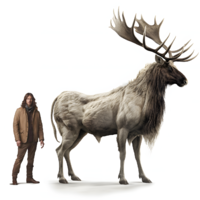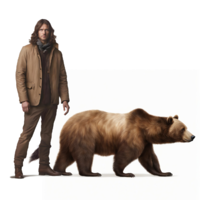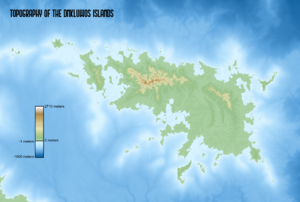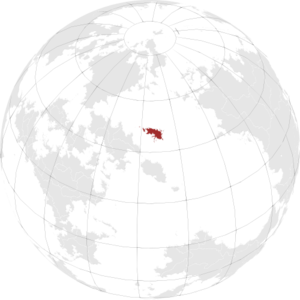| Species
|
Wolgos Name
|
Description
|
Image
|
Notes
|
| Great Elk of Dnkluwos
|
Haiter
|
The great and enigmatic giant elk, revered in Wolgos culture and religion, stands as a majestic symbol of strength and stature. This magnificent creature, distinguished by its impressive height and massive antlers, holds a place of honour in the heart of the Wolgos people. Known not only for its formidable appearance but also for its utility, the giant elk has been domesticated for use as a mount, capable of traversing the diverse terrains of the Dnkluwos Islands.
|

|
Due to their religious significance there are over four thousand in Rissland and fifty thousand in Hergom.
|
| Mountain Wolves
|
Rudhwl̥kwos
|
Larger and hardier than their mainland counterparts, these wolves have adapted to the rugged terrain of the Whwdhoros Highlands. They are notable for their unique rusty-colored fur, with the alpha members displaying a deeper, more intense rust hue.
|

|
Fewer than two thousand remain in the Dnkluwos islands and in reserves in Hergom
|
| Highland Bears
|
Kréukoru
|
These bears are adapted to the boreal forest regions of the islands. They are characterized by their thick fur, which provides insulation against the cold, and a distinctive light cream marking on their faces.
|

|
Less than four hundred remain in the Dnkluwos islands and in reserves in Hergom.
|
| Cliffside Falcons
|
Kléwoséth2r
|
Majestic birds of prey that nest along the steep H3regh'kos cliffs. They are adept hunters over both land and sea, known for their sharp talons and keen eyesight.
|
|
|
| Tidal Basin Marmots
|
Móridhontis
|
Unique to the northern beach sand flats, these marmots are adapted to the tidal ecosystems. They forage for crustaceans, shore crabs, beetles, and other arthropods found in the sandy expanses.
|
|
|
| Forest Boars
|
Dóru-porkos
|
Hardy and aggressive, these forest-dwelling boars are known for their foraging habits, feeding on the abundant mushroom species and roots on the island. They are more aggressive than their Stoldavian counterparts.
|
|
|
| Steaming River Fish
|
Dhombhiskós
|
A unique species of fish that has adapted to the warm waters of the Cinder Plains' steaming rivers. They are scum feeders with whiskers, pale grey to white coloring, and are crepuscular. They thrive in water temperatures around 50 degrees Celsius.
|
|
|
| Geothermal Snakes
|
Kuwnoseks
|
These snakes have adapted to the warm, geothermal areas of the Cinder Plains. They are venomous, with dark black and brown coloring that camouflages them against the rocks. They pose a risk to small mammals and were historically feared by the Eokoesr thermal works slaves.
|
|
|
| Meadow Hares
|
Leugapros
|
Inhabiting the grassy plains, these hares have powerful, long hind legs adapted for evasion from larger predators. They are a crucial part of the island's grassland ecosystems.
|
|
|
| Marshland Heron
|
H3endhuwos
|
Diverse bird species that inhabit the wetlands and marshes. They have long legs and specialized beaks for fishing and foraging in marshy environments.
|
|
|
| Rocky Shore Crabs
|
Karkronebhos
|
These crabs are found in the rocky coastal areas, notable for their cobalt to dark iridescent blue coloring. They play an important role in the coastal ecosystem.
|
|
|
| Alpine Marmots
|
Mormóns
|
Found at higher altitudes in the highlands, these marmots are key to maintaining the alpine ecosystem. They are adapted to the colder and harsher conditions of the highlands.
|
|
|
| Dwarf Shrews
|
Klémūsos
|
Tiny shrews found in the forest undergrowth, no more than 4 cm in length, with distinctive squeaks and dark brown, fussy fur. They play a vital role in the forest floor ecosystem.
|
|
|
| Cave Bats
|
Nektiletus
|
Vampiric bats inhabiting the numerous caves, particularly in volcanic regions. These bats feed on larger mammals, hominids, and insects, exhibiting unique adaptations to their cave environments.
|
|
|
| Moss Frogs
|
Rudhos-Lagwos
|
Small, black frogs with vivid lengthwise red color stripes found in the mossy areas of the forests. They are known for their unique vocalizations and contribute to the forest's biodiversity.
|
|
|
| Island Foxes
|
Astwlp
|
A smaller, more agile species of fox that preys on smaller fauna of the islands. They are adept hunters and play a crucial role in controlling the population of smaller animals.
|
|
|





